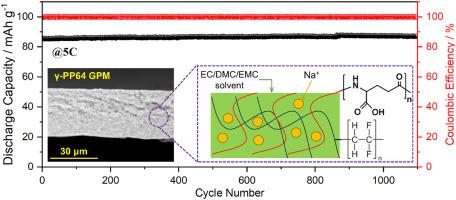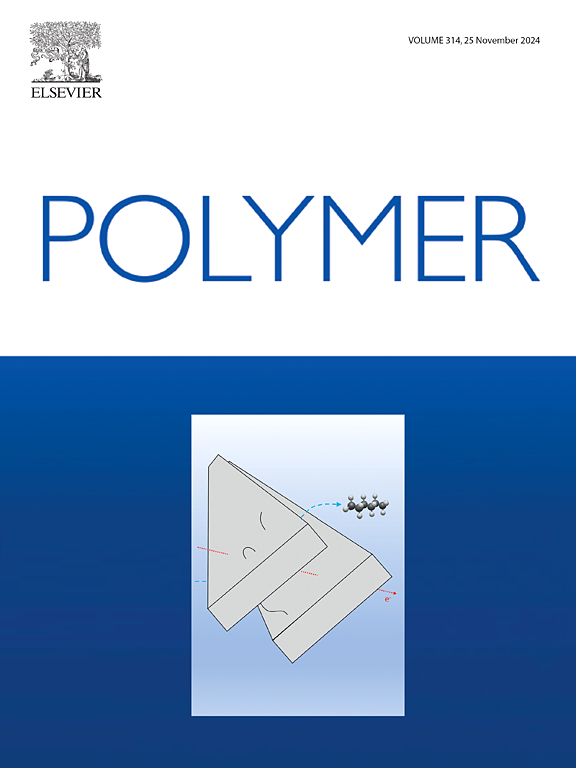用于高倍率和长寿命钠金属电池的聚γ -谷氨酸可降解凝胶聚合物膜
IF 4.1
2区 化学
Q2 POLYMER SCIENCE
引用次数: 0
摘要
钠金属电池(SMB)技术由于其具有成本效益和可持续能源存储解决方案的潜力而越来越受欢迎。然而,阻碍其商业化的一个关键挑战是开发安全、环保和高性能的电解质系统。本研究采用混合溶剂法制备了多γ-谷氨酸(γ-PGA)基中小企业凝胶聚合物膜(GPM)(记为γ-PP64)。所制得的γ-PP64膜厚度约为30 μm,具有多孔结构,电解质吸收率提高至144.4%,在150℃时具有良好的热稳定性。这种结构的创新也促进了Na+离子的迁移(迁移量可达0.11 mS cm-1)和0.536的高迁移数,促进了钠的可逆均匀沉积和溶解。在0.5℃循环测试中,相应的Na/γ-PP64 GPM/Na3V2(PO4)3全电池的初始容量为103 mAh g-1,容量保持率为92.8%。此外,γ-PP64 GPM电池在5℃的高倍率下,经过1100次循环后的容量为87.3 mAh g-1。研究结果突出了基于可生物降解材料的GPM在提高smb性能和寿命方面的潜力,从而为其商业化铺平了道路,并有助于实现储能应用中的环境可持续性目标。本文章由计算机程序翻译,如有差异,请以英文原文为准。


A biodegradable gel polymer membrane derived from poly-gamma-glutamic acid for high-rate and long-lifespan sodium metal batteries
Sodium metal battery (SMB) technology is gaining increasing popularity due to its potential for cost-effective and sustainable energy storage solutions. However, a critical challenge hindering its commercialization is the development of safe, eco-friendly and high-performance electrolyte systems. In this study, poly-gamma-glutamic acid (γ-PGA)-based gel polymer membrane (GPM) for SMBs (denoted as γ-PP64) is obtained using a mixed solvent method. The resulting γ-PP64 membrane with the thickness of about 30 μm exhibits a porous structure that significantly enhances its electrolytes absorption to 144.4 % and excellent thermal stability to 150 °C. This structural innovation also facilitates the migration of Na + ions (up to 0.11 mS cm−1) and high transference number of 0.536, which promotes reversible and uniform sodium deposition and dissolution. During cycling tests at 0.5 C, the corresponding Na/γ-PP64 GPM/Na3V2(PO4)3 full cell demonstrates an initial capacity of 103 mAh g−1 and a 92.8 % capacity retention. Additionally, the γ-PP64 GPM cell records a capacity of 87.3 mAh g−1 after 1100 cycles at a high rate of 5 C. The findings highlight the potential of biodegradable material-based GPM to enhance the performance and longevity of SMBs, thereby paving the way for their commercialization and contributing to environmental sustainability goals in energy storage applications.
求助全文
通过发布文献求助,成功后即可免费获取论文全文。
去求助
来源期刊

Polymer
化学-高分子科学
CiteScore
7.90
自引率
8.70%
发文量
959
审稿时长
32 days
期刊介绍:
Polymer is an interdisciplinary journal dedicated to publishing innovative and significant advances in Polymer Physics, Chemistry and Technology. We welcome submissions on polymer hybrids, nanocomposites, characterisation and self-assembly. Polymer also publishes work on the technological application of polymers in energy and optoelectronics.
The main scope is covered but not limited to the following core areas:
Polymer Materials
Nanocomposites and hybrid nanomaterials
Polymer blends, films, fibres, networks and porous materials
Physical Characterization
Characterisation, modelling and simulation* of molecular and materials properties in bulk, solution, and thin films
Polymer Engineering
Advanced multiscale processing methods
Polymer Synthesis, Modification and Self-assembly
Including designer polymer architectures, mechanisms and kinetics, and supramolecular polymerization
Technological Applications
Polymers for energy generation and storage
Polymer membranes for separation technology
Polymers for opto- and microelectronics.
 求助内容:
求助内容: 应助结果提醒方式:
应助结果提醒方式:


